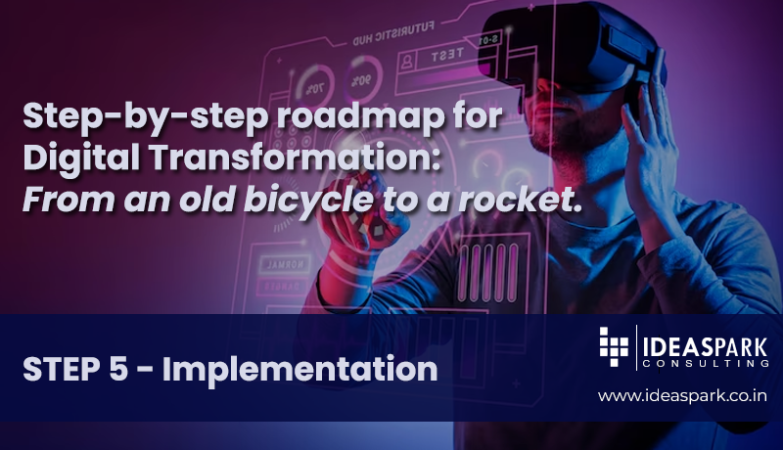In our earlier conversation, we delved into the concept of “Digital Transformation and its initial steps,” and the second step, “Set Clear Objectives.” If you haven’t had the opportunity to review it yet, please take a moment to explore the respective links provided.
Introduction: In the pursuit of digital transformation, a strategic roadmap is crucial to navigate the journey from outdated processes, akin to an old bicycle, to the agility and efficiency symbolized by a rocket. Having already addressed the initial steps of assessment, planning, and goal-setting, this report focuses on the pivotal phase of Technology Selection.
Technology Selection Overview: The Technology Selection phase is akin to selecting the right components for constructing a rocket. It involves careful consideration of various technologies that align with the predefined objectives. The goal here is to build a tech stack that not only addresses current challenges but also propels the organization toward its digital aspirations.
“The art of digital transformation lies in the strategic selection of technologies—a thoughtful blend that not only meets current needs but propels the organization towards an innovative and resilient future.” ~ Olivia Wilson, Chief Technology Officer at IdeasPark Consulting
Key Steps in Technology Selection:
Alignment with Objectives: Purpose-Driven Technology Adoption
In the context of digital transformation, the alignment of chosen technologies with predefined objectives is pivotal for success. The selected technologies should seamlessly integrate into the organizational framework, directly contributing to the achievement of predetermined goals. This ensures a purpose-driven approach to technology adoption, reinforcing the strategic direction of the digital transformation initiative.
Scalability and Flexibility: Adaptable Solutions for Dynamic Needs
Scalability and flexibility are crucial considerations in the selection of technologies for digital transformation. Opting for scalable solutions that evolve in tandem with the dynamic needs of the organization is essential. Prioritizing flexible technologies facilitates seamless integration with existing systems, preventing disruptions and allowing for an agile response to changing business requirements. This adaptability ensures that the technological foundation can grow in parallel with the organization’s evolving landscape.
Interoperability: Building a Cohesive Digital Ecosystem
Interoperability is a cornerstone in creating a cohesive digital ecosystem. The choice of technologies should enable seamless interaction, eliminating silos, and enhancing overall operational efficiency. Prioritizing interoperable solutions fosters an integrated environment where disparate systems work harmoniously, fostering collaboration and streamlining processes for optimal digital synergy.
Security Considerations: Robust Defenses for Digital Assets
Security considerations are paramount to safeguard sensitive data and ensure compliance with industry regulations. Prioritizing technologies with robust security features establishes a resilient defense against potential threats, instilling confidence in stakeholders and protecting the organization’s digital assets. This strategic emphasis on security contributes to the overall resilience of the digital infrastructure.
User-Friendly Interface: Maximizing Efficiency through Intuitive Design
The user-friendly interface plays a pivotal role in the successful adoption and effectiveness of technologies. Selecting technologies that promote user adoption and ease of use is crucial for maximizing efficiency. Prioritizing solutions with intuitive interfaces minimizes training requirements, empowering users to leverage technology to its full potential. This ensures a smooth transition to the new digital landscape and enhances overall user satisfaction.
Vendor Support and Reliability: Building Partnerships for Success
When assessing technology vendors, reliability and support capabilities become critical factors. Organizations should thoroughly evaluate the track record of potential partners and prioritize collaborations with established vendors known for consistent support. This proactive approach ensures a stable technological infrastructure and provides assurance that the chosen technologies will be backed by reliable support, minimizing downtime, and maximizing the success of the digital transformation initiative.
In conclusion, the Technology Selection phase is a critical milestone in the digital transformation journey. By carefully aligning technologies with objectives and considering scalability, interoperability, security, user-friendliness, and vendor reliability, organizations can construct a robust tech foundation that propels them towards their digital destination. The roadmap, akin to transitioning from an old bicycle to a rocket, becomes more defined as each technology is strategically chosen to power the transformation journey.
For a FREE assessment, connect with our Sales department at [email protected] or WhatsApp 91-8904207147.
Moving forward in the Digital Transformation process, the upcoming focus will be on Data Migration and Integration—a topic that we’ll explore in the next segment.
#DigitalTransformation #BusinessInnovation #TechUpgrade #EfficiencyJourney #StrategicChange #ProcessImprovement #InnovationDrive #TechEvolution #DigitalStrategy #BusinessTransformation #ChangeManagement #FutureOfWork #AdaptiveTech #EvolvingBusiness #TechIntegration #Modernization #DigitalAdvancement #InnovateOrStagnate #BusinessEfficiency #TechRevolution #AgileBusiness #DigitalInnovation #TransformativeTech #StrategicPlanning #OptimizeProcesses #TechLeadership #EfficientOperations #BusinessGrowth #AdaptAndThrive #FutureReadyBusiness








